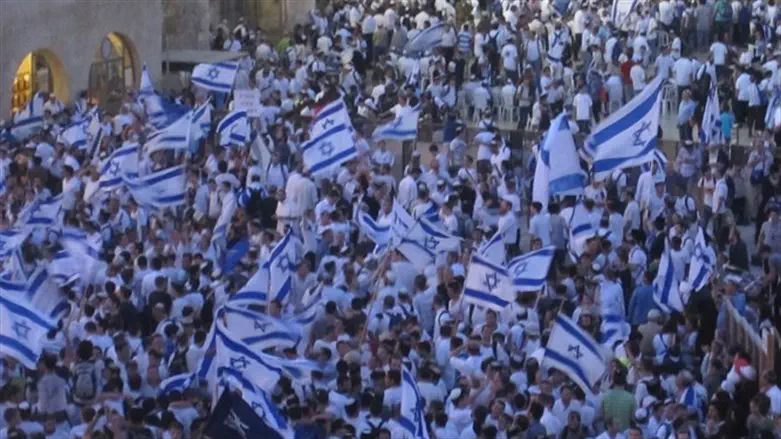
As spokesperson and board member of “Am K’Lavi” which organizes the annual Rikuddgalim, the flag-waving Jerusalem Day Parade to the Kotel, I stridently refute the claims of Hamas that we intend to attack the Temple Mount and destroy the al-Aksa mosque, as reported by Israel Nationa News.
In response to the headline which declares: “Hamas calls on Arabs to fight Jerusalem Day Flag March” we call upon all Jews to help make this year’s upcoming parade the largest Jerusalem Day parade ever, expressing our eternal love and loyalty to our Holy City, as King David vowed, “If I not set Jerusalem above my highest joy.”
Each year, the pinnacle of Jerusalem Day celebrations is the flag-waving parade to the Kotel, attended by some fifty-thousand-plus lovers of Jerusalem, most of them young people from the Religious Zionist community. Hundreds of buses arrive in the city in the early afternoon from all over the country. Women gather near the Great Synagogue, and men in a separate location, in order to separate genders as much as possible during the crowded march so that all sectors take part.
With thousands of blue-and-white flags waving like Zionist oceans, the youngsters dance in circles and follow after musical bands riding on flat-bed trucks which converge on the Old City from several directions to symbolize the unification of Jerusalem and Jewish sovereignty over the Holy City.
The festive parade was originated by the late Rabbi Yehuda Hazani, a longtime student of HaRav Tzvi Yehuda HaKohen Kook, head of the Mercaz HaRav Yeshiva, who taught a generation of ardent, young Torah scholars to recognize the Hand of Hashem in the establishment of Medinat Yisrael, and in Israel’s liberation of Jerusalem and the Biblical landscapes of Judea and Samaria during the Six-Day War.
Every year, come midnight, after the festive Jerusalem Day celebration at the Mercaz HaRav Yeshiva, HaRav Tzvi Yehuda would lead his students as they danced and sung from the Kiryat Moshe neighborhood at the entrance to the city, all the way along Jaffa Road to the Kotel. (Several years ago, the police stopped allowing the midnight march, fearing that they could not protect the marchers in the dark Old City area.)
To attract more people, Rabbi Hazani established a separate march for the daytime and the Rikuddgalim was born.
Rabbi Yaacov Novik took over the organization of the march after Rabbi Hazani’s untimely death. He asserts: “For the past decade the Arabs have tried to thwart the success of the parade with all kinds of preposterous claims, especially the cry that we intend to blow up the mosque on the Mount. It is absolutely ridiculous. Never once in the past 25 years have we attempted to ascend to the Temple Mount. Everyone remembers how Hamas shot missiles from Gaza during the parade a few years ago. As usual, it is the Arabs who are inciting to violence, not the Jews.”
Meir Indor, a co-organizer of the parade, explains: “Since its inception, the police have been very supportive of the parade, not objecting to our marching through the Shechem Gate into the predominately Arab neighborhood on the way to the Kotel. Any altercations along the way have been minimal. Because of the cooperation of the police, the Supreme Court has turned down the appeals that the parade be canceled, notably coming from leftist groups, though occasionally, it has refused to permit certain routes through Arab neighborhoods.”
When the paratroopers captured the Kotel during the Six-Day War, the foreign media interviewed HaRav Tzvi Yehuda Kook who was rushed to the scene by Rabbi Goren, the IDF Chief Rabbi. “We proclaim to world that the Jewish People have come home to their eternal capital – Jerusalem,” Rabbi Kook told them. “And we will never leave!”
That will be the message of the parade this year as well.